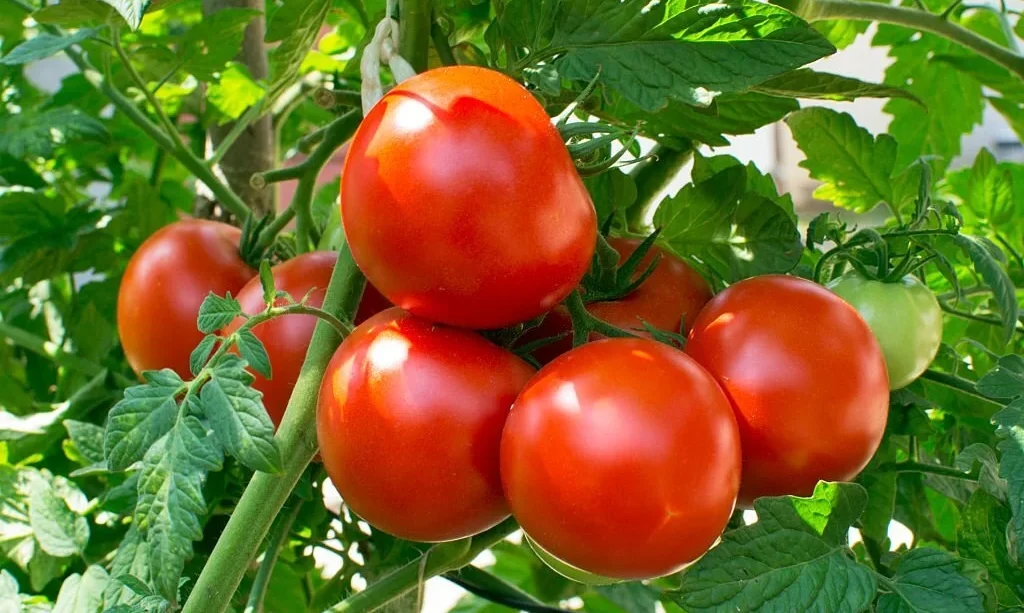Florida’s warm and sunny climate offers an ideal environment for growing delicious and juicy tomatoes. Whether you’re an experienced gardener or a beginner, cultivating tomatoes in the Sunshine State can be a rewarding experience. To ensure a successful tomato harvest in Florida, it’s essential to follow specific guidelines tailored to the region’s unique weather conditions and challenges. In this comprehensive guide, we will walk you through the steps to grow thriving tomatoes in Florida, starting with the crucial task of selecting the right tomato varieties.
- Two (2) large live plants – big, healthy, ready to grow, premium tomato plants, 4” to 8” tall plants, in 4” pots. NON GMO No Neonicotinoids
- This great performer holds a Guinness World record for highest yielding tomato plant! These succulent, juicy and meaty tomatoes make great slicers for burgers and sandwiches, taste in delicious in salsas, sauces and are perfect for canners
- An indeterminate variety that produces tomatoes until frost. 10x Root Development means these plants grow stronger right from the start
- Grown in the Midwest. Plant in any US Zone. Plant in containers, small spaces, balconies, patios or large gardens. Larger plants benefit from caging or staking. Treat as a tender annual in Zones 9 and colder
- Careful Packaging. Your fresh plants arrive quickly in our exclusive, eco-friendly, 100% recyclable box. 100% Satisfaction Guarantee. Includes our Clovers Garden copyrighted Quick Start Planting Guide
Choose the Right Tomato Varieties
- Selecting Heat-Tolerant Varieties: Florida’s hot and humid climate demands tomato varieties that can thrive in these conditions. Look for heat-tolerant cultivars known for their ability to withstand high temperatures. Examples include ‘Florida 91,’ ‘Solar Fire,’ and ‘Heatmaster.’
- Disease Resistance: Florida is known for its tomato diseases, such as bacterial spot and fusarium wilt. Choose tomato varieties with built-in resistance to these common Florida tomato ailments. Disease-resistant cultivars help ensure a healthy and fruitful harvest.
By starting with the right tomato varieties, you lay a solid foundation for a successful tomato-growing venture in Florida. These carefully selected varieties are better equipped to handle the state’s climate and potential challenges, setting the stage for a bountiful tomato harvest.
Timing and Planting
Planting Seasons: In Florida, you have the advantage of being able to plant tomatoes in both the fall and spring. Consider the following:
- Fall Planting: Ideal for many regions in Florida, fall planting allows tomatoes to mature during the cooler months, reducing the risk of fruit sunscald.
- Spring Planting: In areas with mild winters, spring planting is suitable. However, be cautious of late frosts, and protect young plants if needed.
Transplants vs. Seeds: Decide whether to start with transplants or seeds:
- Transplants: Using transplants can provide a quicker harvest, especially for fall planting. Purchase healthy seedlings from a nursery or start your own indoors.
- Seeds: Starting from seeds indoors allows you to control the growing conditions. Begin seeds 6-8 weeks before your intended outdoor planting date.
Site Selection and Soil Preparation
- Sunlight: Tomatoes thrive in full sun, so choose a planting location that receives at least 6-8 hours of direct sunlight per day. Ensure there’s no excessive shade from nearby trees or structures.
- Well-Draining Soil: Prepare the soil by ensuring it is well-draining. Tomatoes do not tolerate waterlogged roots. To improve soil quality, amend it with organic matter such as compost or well-rotted manure. Raised beds can also help with drainage.
By carefully considering the timing of your tomato planting and preparing the soil and site accordingly, you set the stage for healthy and robust tomato plants that can thrive in Florida’s unique climate. These steps are essential for ensuring your tomatoes receive the right growing conditions and can produce a bountiful harvest.
- Made with premium ingredients
- Contains compost, peat moss, aged bark and lime
- Great for improving and revitalizing the soil in and around your vegetable garden beds
- Naturally lightweight and contains just the right ingredients to grow plentiful, flavorful tomatoes and vegetables
- 20-quart bag
Proper Watering
Consistent Moisture: Florida’s warm climate demands consistent moisture for tomato plants, but it’s crucial to strike a balance to prevent water-related issues. Keep the following in mind:
- Drip Irrigation or Soaker Hoses: Use drip irrigation or soaker hoses to deliver water directly to the root zone, minimizing foliage wetness and reducing the risk of diseases.
- Morning Watering: Water your tomato plants in the morning to allow the foliage to dry during the day, reducing the chances of fungal infections.
- Monitor Soil Moisture: Regularly check the moisture level of the soil. It should be evenly moist but not waterlogged. Adjust your watering schedule based on weather conditions to avoid both drought stress and waterlogged roots.
Fertilization
Balanced Fertilization: Tomatoes require a balanced supply of nutrients for healthy growth and abundant fruit production. Follow these guidelines:
- Slow-Release Fertilizer: Use a slow-release, granular fertilizer formulated for vegetables. This ensures a steady nutrient supply over time.
- Organic Options: Consider organic fertilizers like compost or well-rotted manure to improve soil fertility.
- Follow Recommendations: Always follow the recommended application rates on the fertilizer package. Over-fertilization can lead to excessive foliage growth at the expense of fruit development.
Proper watering and fertilization practices are vital to sustaining healthy tomato plants in Florida’s climate. By providing consistent moisture and essential nutrients, you support vigorous growth and ensure your tomatoes can withstand the heat and humidity of the region, ultimately leading to a successful harvest.
- Increases Vigor And Volume Of Tomatoes And Vegetables
- Ideal For Vegetables, Trees, Shrubs And Flowers
- Helps Plants Tolerate Drought
- No Assembly Required
Pest and Disease Management
Common Pests: In Florida, tomato plants are vulnerable to a range of pests, including whiteflies, aphids, and hornworms. Here’s how to address these challenges:
- Natural Predators: Encourage the presence of beneficial insects like ladybugs and parasitic wasps, which can help control pest populations.
- Neem Oil: Apply neem oil or insecticidal soap to deter and manage common pests. Regular monitoring of your plants is key to early pest detection.
Disease Prevention: Florida’s warm and humid conditions can lead to tomato diseases like bacterial spot and fungal issues. To prevent these:
- Disease-Resistant Varieties: Choose tomato varieties with built-in resistance to common Florida tomato diseases.
- Sanitation: Remove and dispose of any diseased plant material promptly to prevent the spread of diseases.
Support and Pruning
Staking or Caging: Supporting tomato plants is essential to keep the fruit off the ground, preventing rot and making it easier to harvest. Options include:
- Stakes: Use stakes to support individual plants, tying them as they grow.
- Cages: Tomato cages offer stability and support for multiple plants in a compact space.
Pruning: Proper pruning can improve air circulation and reduce disease pressure. Remove the lower branches of the plant and any non-fruiting “suckers” that develop in leaf axils.
By effectively managing pests and diseases, providing adequate support, and practicing appropriate pruning techniques, you can maintain healthy tomato plants that thrive in Florida’s conditions. These steps help protect your tomato crop from potential threats while encouraging strong growth and productive fruiting.
- MAKE PRUNING WORK EASIER: Rust-resistant stainless steel blade are sharp and durable for easy and smooth cut.Anti-slip and ergonomic handle make the gardener clippers more comfortable in your hand.Easy-open spring action reduces hand fatigue while cutting. you can easily to cut without damaging the vital stems and branches of your plants.
- User-FRIENDLY SAFETY LOCK:These garden shears have locking mechanisms to keep the sharp blades securely closed when not in use.It is easy to maneuver and can effectively reduce accidental injuries.
- GARDEN GLOVES: This Gardening gloves,made of soft & comfortable cotton fabric,can protect yourself from dirt, skin wounds and nasty splinters when doing yard chores. The grip latex coating provides anti-slip or sure control when grabbing garden & yard tools.
- COMFORTABLE HANDLE: The handle part of the pruning shears made by high-purity PP+TPR plastic, especially the hand grip is very comfortable, but also has strong toughness and strength.
- PACKING LISTING: The packing include pruning shear, fruits shear, flower cutter, leaves trimmer, one pair glove, one organizer bag.Those pruning shears could satisfy need of planting, harvesting, floral, indoor and outdoor planting, greenhouse pruning.
Harvesting
Timing: Harvest your tomatoes at the right stage of ripeness to enjoy the best flavor and texture. Here’s how to do it:
- Ripeness Indicators: Look for tomatoes that have reached their mature color and are firm but not hard. They should yield slightly to gentle pressure.
- Regular Picking: Harvest ripe tomatoes regularly to encourage the plant to keep producing. Leaving overripe fruit on the vine can attract pests.
Conclusion
Cultivating tomatoes in Florida is not without its challenges, but with the right knowledge and strategies, you can enjoy a bountiful harvest of fresh, homegrown tomatoes. By choosing heat-tolerant varieties, carefully timing your planting, preparing the soil, providing proper watering and fertilization, managing pests and diseases, offering support, and following correct harvesting practices, you can successfully grow tomatoes in the Sunshine State.
Remember that gardening is a dynamic process, and learning from your experiences each season will help you refine your techniques and achieve even greater success in the future. With dedication and attention to detail, you can savor the taste of freshly picked, homegrown tomatoes that thrive in Florida’s unique climate.







